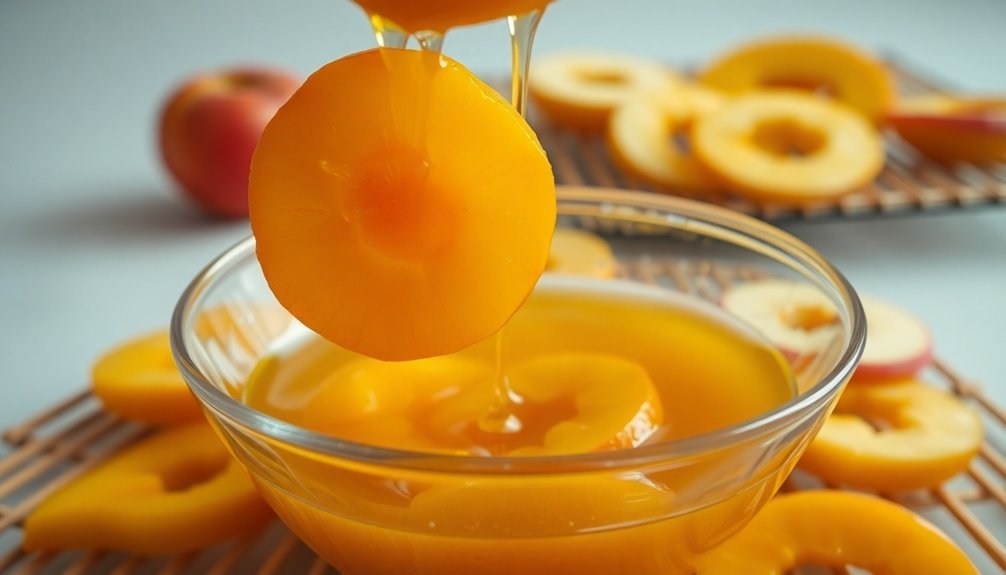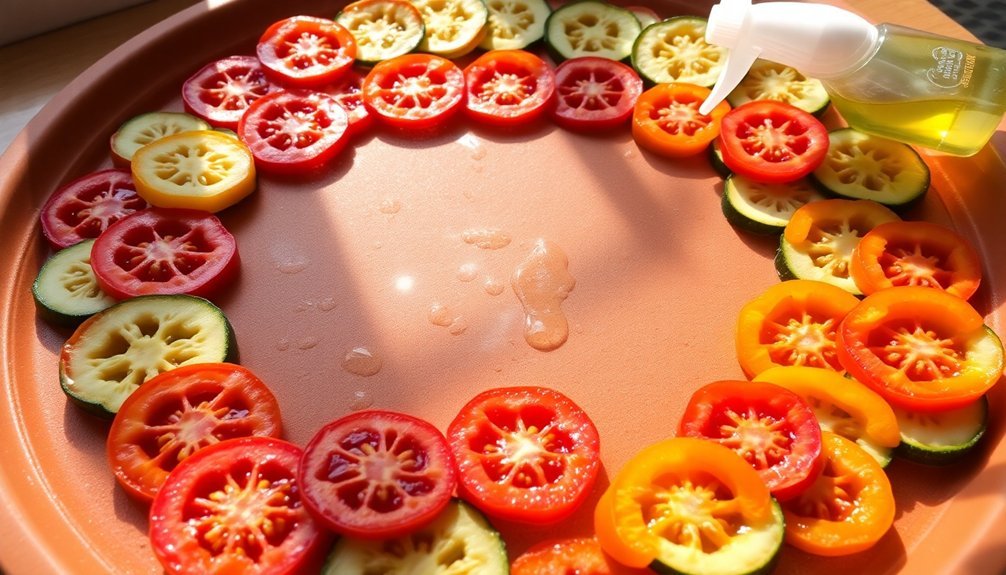To lock moisture when preparing sun-dried meals, you'll need three essential techniques. First, pre-treat your foods using an ascorbic acid solution (1 tsp powder per 2 cups water) or citric acid bath (1 tsp per quart) for 3-10 minutes to preserve nutrients and prevent darkening. Second, create protective layers using cheesecloth or stainless steel screens to shield food while allowing proper airflow. Third, maintain strict temperature control between 85-100°F (29-38°C) and keep humidity below 60% for ideal moisture removal. These foundational steps will jumpstart your journey toward mastering the art of sun-dried food preservation.
Pre-Treatment Dipping Methods

Before sun-drying your fruits and vegetables, you'll need to apply pre-treatment dipping methods to lock in moisture and preserve quality. You can choose from several effective solutions, including ascorbic acid, sodium metabisulfite, fruit juices, or citric acid.
For ascorbic acid treatment, mix 1 teaspoon of powder with 2 cups of water and dip produce for 3-5 minutes. If you prefer sulfites, create a 4-8% sodium metabisulfite solution with varying dip times up to 7.5 minutes.
For a natural alternative, combine equal parts vitamin C-rich fruit juice and cold water, soaking items for 3-5 minutes. You can also use citric acid by mixing 1 teaspoon per quart of water and soaking for ten minutes. Using proper treatment methods is essential since sun drying alone can be risky for vegetables and produce inconsistent results.
Each method helps prevent darkening while maintaining flavor and nutritional value.
Protective Layer Applications
After preparing your fruits and vegetables with protective dips, you'll need to set up proper barriers to shield your food during the drying process.
You'll want to use stainless steel screens or Teflon-coated fiberglass to prevent metal residues, while avoiding copper and aluminum screens that can destroy vitamin C.
For outdoor drying, cheesecloth is your best friend – it maintains airflow while keeping birds and insects away. The ideal temperature for successful sun drying should be at least 85 degrees Fahrenheit.
- Place your drying racks on reflective surfaces like aluminum sheets or concrete driveways to speed up the process.
- Set up two screens – one as a shelf and another as a cover – to protect your food while ensuring proper air circulation.
- Elevate your trays on blocks to prevent ground moisture from affecting your sun-dried goods.
Controlled Temperature Drying Process

To achieve perfectly dried foods, maintaining precise temperature control throughout the drying process is essential.
You'll want to keep temperatures between 85-100°F (29-38°C) for most foods, though your solar dehydrator can safely operate up to 185°F.
Don't let temperatures exceed 140°F, as this can cause case hardening and accidentally cook your food instead of drying it.
The ideal drying environment requires humidity below 60% for optimal moisture removal.
You can boost your drying temperature by 20-30°F using reflective materials like aluminum foil or glass.
If you're in a humid area, use a solar dehydrator with built-in fans to speed up the process and guarantee consistency.
Remember to monitor conditions with a hygrometer and thermometer, and position your drying racks to catch prevailing breezes.
This combination of controlled temperature and proper air circulation will help you achieve peak results.
Frequently Asked Questions
Can Dried Foods Be Rehydrated to Their Original Texture and Taste?
You'll find that most dried foods can be rehydrated to closely match their original texture and taste, especially if they're freeze-dried. Just add water, and they'll quickly absorb it back into their cellular structure.
How Do You Identify Mold Growth in Stored Sun-Dried Foods?
You'll spot mold in sun-dried foods by checking for fuzzy patches in white, green, or black colors. Watch for musty odors, slimy textures, and discoloration. If it smells off or tastes bitter, discard it.
What Alternative Containers Work if Vacuum-Sealed Bags Aren't Available?
You can use airtight glass jars, mylar bags, or resealable silicone containers for storing sun-dried foods. For shorter trips, double-sealed Ziploc bags work well, but they're not ideal for long-term storage.
Does Altitude Affect the Drying Time of Foods?
Yes, altitude considerably affects your food's drying time. You'll experience slower drying at higher altitudes due to lower air pressure and temperature, though the typically lower humidity levels can help balance this out.
Can Sun-Dried Foods Be Used in Microwave Cooking?
Yes, you can microwave sun-dried foods after proper rehydration. You'll need to guarantee they're fully soaked, use a microwave-safe container, and stir occasionally for even heating during the cooking process.
In Summary
You've learned three effective techniques to prevent moisture loss when making sun-dried foods. By dipping ingredients in citrus solutions, applying protective layers like honey or oil, and carefully controlling the drying temperature, you'll preserve more nutrients and flavor. These methods will help you create delicious sun-dried meals that maintain their quality and prevent excessive dryness during the preservation process.





Leave a Reply